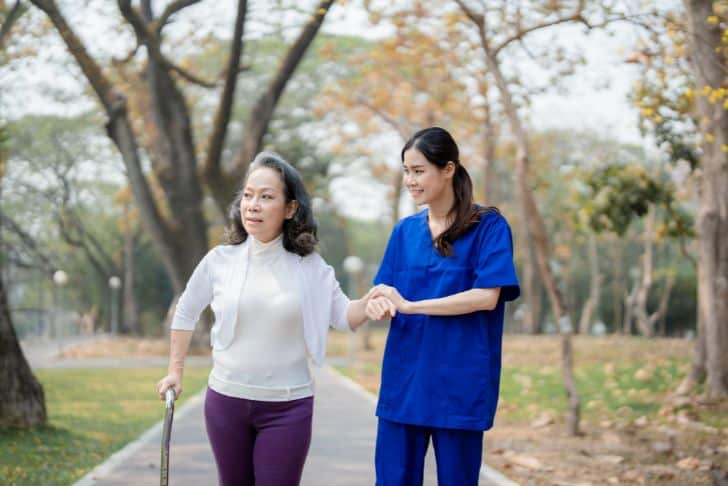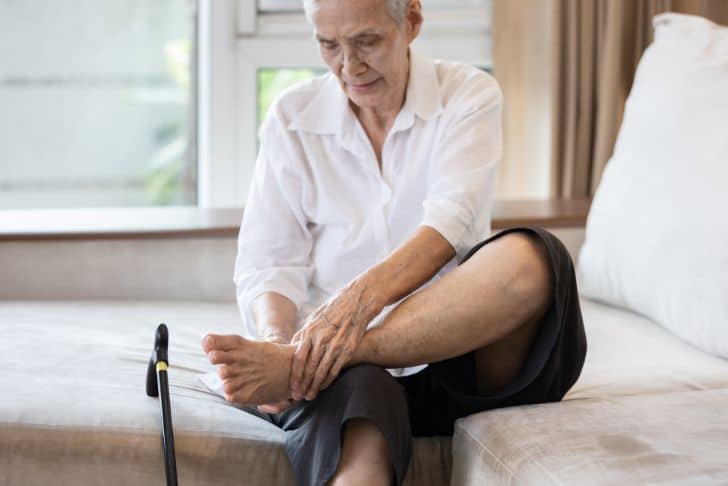“Improving Joint Mobility and Preventing Falls: A Guide to Physiotherapy for the Elderly” is an enriching article that gracefully navigates you through a series of eight simplified stretching and balancing exercises, specifically crafted for older adults. The thoughtful compilation aims at escalating your joint mobility while preventing any unwanted falls, countering the natural decrease in bone density that comes with aging. The guide walks you through each exercise, from an easy doorway stretch to encouraging calf stretches, beneficial shoulder and ankle rolls, knee-to-chest compressions, and balance-enhancing heel-to-toe walking.
The concluding exercises, like sit to stand repetitions and light-weight biceps curls, are designed to instill in you a new surge of strength. In addition, the article reveals how the proficient team at Virtua Physical Therapy offers convenient telehealth visits alongside physical locations to help older adults regain balance and vigor, making it an ideal read for anyone who values their mobility and strength in the twilight years.

Understanding the Importance of Physiotherapy for the Elderly
Physiotherapy is often overlooked as a vital part of ageing well. But, as we age, our bodies go through a number of changes and physiotherapy can help us navigate these changes with grace and strength. It assists in managing persistent, long-term health conditions, aiding in fall prevention and enhancing overall quality of life.
Role of physiotherapy in ageing process
As you age, you may find that your mobility decreases, your joints become stiffer and you just can’t perform physical tasks as easily as you used to. This is part of the natural ageing process. Physiotherapy can help slow down these effects, it teaches techniques to maintain physical strength and flexibility, helps manage pain, and ultimately, promotes independence and confidence.
Benefits of physiotherapy to seniors
Physiotherapy offers diverse benefits to seniors. It can enhance overall functionality by improving stability, flexibility, and muscle strength. Besides, it assists in pain management, especially chronic pains, a common complaint in the elderly. Regular physiotherapy can support improved sleep quality too and supports heart and lung health by providing cardiovascular and pulmonary rehab.
Overview of joint mobility and fall prevention
An essential element of physiotherapy is to improve joint mobility and prevent falls. As you age, joints tend to stiffen reducing their range of motion making you more prone to falls. Physiotherapy can provide you with exercises specifically targeted at improving joint mobility and balance, thereby reducing the incidence of falls.
Factors Influencing Joint Mobility and Risk of Falls
Ageing affects every part of your body, and joints are no exception. Various factors influence joint mobility and hence the risk of falls.
Effect of age on bone density
As you age, you might notice a gradual loss of bone density. This is a natural process, but it can make your bones more brittle and susceptible to fractures. More so when accompanied by reduced joint flexibility and muscle strength.
Impact of lifestyle and diet on mobility
A sedentary lifestyle, coupled with a poor diet, can hasten age-related declines in mobility. Regularly performing physical activities can maintain or even improve your mobility. Additionally, nutrition also plays a crucial role. A diet low in calcium, protein and vitamin D can rapidly affect bone strength leading to a greater risk of fractures.
Medical conditions affecting joint mobility
Certain chronic diseases like arthritis, diabetes, osteoporosis can adversely impact joint mobility and balance, increasing the risk of falls. Regular physiotherapy can help manage these conditions.
Stretching and Balancing Exercises for the Elderly
An integral part of physiotherapy is performing stretching and balancing exercises. These are crucial for the elderly because they can help maintain flexibility, strength and balance.
Why stretching and balancing matters
As you age, muscles tend to lose their flexibility and elasticity, this can restrict your movements and make you prone to injuries. Stretching exercises help regain this flexibility. Balancing exercises, on the other hand, help maintain stability, reducing the risk of falls.
Preparation for these exercises
Before starting any exercise regimen, it’s crucial to have a plan. Start slow and gradually increase the intensity. Please make sure to warm up beforehand, ideally starting with a light cardiovascular exercise such as walking. Warming up increases blood flow in your muscles, making them more flexible and less prone to injury.
Time and frequency of exercises
Ideally, you should perform stretching and balancing exercises two to three times per week. Each session should last about 30-45 minutes. Remember, consistency is key.
Detailed Description of Stretching Exercises
Stretching exercises can provide many benefits. They help preserve flexibility, improve balance, and ease joint pains.
Doorway stretch overview
Start this exercise by standing in a doorway. Brace your forearms against the frame and push your front leg through the doorway. Hold the position for 20-30 seconds per side.
Calf stretch guide
For the calf stretch, stand facing the wall. Step back with your right foot, keep your heel on the ground and lean forward with your right knee straight. Hold for 30-60 seconds per side.
Instruction for knee to chest
Lie on your back with your knees bent. Bring one knee to your chest and hold for 15-30 seconds. Repeat with the other leg.
How to perform bicep curls
Hold light weights in your hands with your palms facing in. Bend your elbows towards your shoulders while turning your palms up. Repeat for 10 to 15 reps.

Detailed Description of Balancing Exercises
Balancing exercises are perhaps the most crucial component of physiotherapy for seniors as these exercises reduce the risk of falls.
Ankle rolls guide
Standing on one foot, rotate your raised ankle in a circle, ten times in each direction. Ankle rolls help enhance your balance and ankle stability.
Heel-to-toe walking instructions
Position the heel of one foot just in front of the toes of the other foot. Try to maintain your balance, and walk slowly in a line for 20 steps. This exercise strengthens your lower body and helps in maintaining balance.
Explanation of sit to stand exercise
Sit in the middle of the chair, with your arms crossed over your chest. Now, rise to a standing position and then sit back down again. Repeat the process 10-15 times. This exercise is great for leg strength and overall stability.
Ensuring Safety While Conducting Exercises
Safety is of prime importance while exercising, especially in the elderly. Correct setup and professional guidance can ensure that you reap the benefits of exercise safely.
Environment setup for safe exercise
Make sure your workout space is safe and spacious enough to prevent accidents. Remove any tripping hazards and ensure the space is well lit. It’s beneficial to have someone nearby during your exercise session.
The role of professional guidance
Professional guidance is crucial to ensure that you are performing exercises correctly and safely. A physiotherapy professional can guide you through the exercises, monitor your form, and prevent you from potential injuries.
Coping with discomfort during workouts
While exercising, it’s normal to feel a mild discomfort. But if the discomfort intensifies, it’s important to stop and take rest. Pain is a signal that something might be wrong. Always listen to your body and modify exercises if necessary.

Role of Physiotherapy in Fall Prevention
Physiotherapy plays a significant role in fall prevention for the elderly. Regular sessions can improve stability, strength, and overall mobility which are key in fall prevention.
Links between regular physiotherapy and fall prevention
Regular physiotherapy can drastically reduce the risk of falls. It can improve your balance, mobility, and increase your body strength, which are all factors in preventing falls.
Strategies adopted by Physiotherapists for fall prevention
Physical therapists adopt various strategies for fall prevention. They assess an individual’s balance and strength, review medical history, and design a personalized exercise regimen. This strategic and individualized approach effectively reduces the risks of falls.
Case study: Impact of physiotherapy on fall rates
Numerous case studies show the positive impact of physiotherapy on fall rates among seniors. Regular physiotherapy sessions have proven to significantly reduce the risk of falls and also improve the overall quality of life.
Physiotherapy Sessions: In-house Vs Telehealth
In today’s virtual age, physiotherapy sessions can take place in the clinic or via telehealth. Both have their own benefits and drawbacks.
Understanding telehealth for physiotherapy
Telehealth allows you to receive physiotherapy services at the comfort of your home. It enables you to engage in therapy while eliminating travel times and the stress of regular hospital visits.
Benefits and drawbacks of in-house visits
In-house physiotherapy visits provide the opportunity for hands-on treatment, and professionals can easily monitor your progress and reactions to the therapy. But these may involve regular commutes which might be stressful, especially for seniors.
Benefits and drawbacks of telehealth visits
Telehealth physiotherapy offers flexibility. You can arrange appointments based on your convenience. However, it may not be as effective if you need hands-on assistance. Also, you may need certain technical skills to navigate through tele-applications.
Choosing the Right Physiotherapy Service
Searching for the right physiotherapy service might appear overwhelming at first. However, by considering few key factors you can easily decide on the right service for your needs.
Things to consider when selecting a physiotherapy service
When selecting a physiotherapy service, consider factors such as their reviews and testimonials, offerings, convenience, the expertise of the therapists, and of course, cost. Make sure the service aligns with your needs and preferences.
Understanding the offerings of Virtua Physical Therapy
Virtua Physical Therapy offers both in-person and telehealth sessions, providing you with flexibility. They have experienced professionals who are dedicated to improving your strength and balance.
Reviews and testimonials about Virtua Physical Therapy
Reviewing testimonials is an excellent way to get an idea about the service quality. Most testimonials about Virtua Physical Therapy report improved strength and balance, reduced pain and a better quality of life.
Closing Remarks on Physiotherapy for the Elderly
In conclusion, physiotherapy is an essential component in maintaining optimal health as you age. It offers multiple benefits like enhanced mobility, fall prevention, and pain management enhancing your overall quality of life.
Remaining committed to physiotherapy
The Key to reaping the benefits of physiotherapy is staying committed. Remember, it’s not just about attending sessions but also diligently performing advised exercises at home.
Continual assessment of progress
It’s crucial to assess your progress regularly. This will help your therapist adjust your program as needed, ensuring that it remains effective and personalized towards your needs.
Maintaining a balanced lifestyle for optimal joint health
While physiotherapy is highly beneficial, it is only one piece of the puzzle. A balanced lifestyle, which includes a healthy diet, regular exercise, and adequate rest, is critical for maintaining optimal joint health. Stay positive and committed, and remember you’re in the process of creating a healthier future for yourself.
